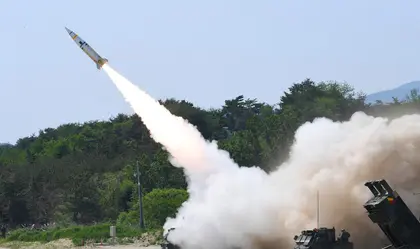As Russia launches as many as 80 of its Shahed-136 / Geran-2 kamikaze drones against Ukrainian cities every day there is a need for a cost-effective weapon to use against them to minimize the number of expensive missiles expended from the limited stocks Kyiv holds.
The Wild Hornets volunteer group has recently disclosed its latest development aimed to do exactly that – the first-person view (FPV) “Sting” unmanned aerial vehicle (UAV drone). The UAV is said to be capable of speeds exceeding 160 kph (100mph) and reaching altitudes of around 3,000 meters (10,000 feet).
JOIN US ON TELEGRAM
Follow our coverage of the war on the @Kyivpost_official.
Sting is based on a standard quadcopter to which is centrally fixed an elongated dome-shaped warhead on top of which is a camera that is used to guide the UAV during it flight. The operator controls the drone remotely from the ground using VR goggles that allow him / her to steer the Sting onto its target.
Wild Hornets say they are also working on developing an artificial intelligence add-on for the targeting system which will further improve the drone’s ability to identify and lock on to its target.
This is the latest in innovative drone system the group has developed. Wild Hornets was set up in the spring of 2023 in response to the calls by the Ukrainian armed forces for more drones in its fight against Russia. Production started slowly in 2023, with the group churning out only tens of drones a month before rising to hundreds and then thousands as of today.

Eurotopics: Ukraine Hits Russian Target with US Missiles
According to co-founder, Dmytro Prodanyuk, there are more than 25 engineers working on drones producing around 100 per day. These include:
Standard Wild Hornets: Kamikaze FPV quadcopter drones capable of carrying payloads of 1.5 - 3 kilograms (3.2-6.5 pounds) and reaching speeds of up to 160 kph (100 mph)
The Queen Hornet: A “supersized” bomber drone that can carry up to 5-kilogram (11-pound) bombs with a range of 30 kilometers with a planned mission life of 10 – 30 sorties.
Interceptors: UAV specifically designed to chase and catch Russian reconnaissance drones in flight, equipped with a new camera and high-capacity batteries to allow for air-to-air intercepts.
Sting: Designed specifically to destroy larger Shahed-type kamikaze drones, said to cost one-tenth of that of a Shahed drone which is estimated to cost upwards of $50,000 (and up to 1,000th of the cost of a Patriot surface-to-air missile).
Wild Hornets’ drones are made with Ukrainian components, including electronics they have developed themselves during the course of the war. While they still have to import some key elements, such as motors, the group recently confirmed that it has designed and is manufacturing its own flight controllers.
You can also highlight the text and press Ctrl + Enter






